In this, our last term of classes at Longwood (wah!), one of the subjects we will learn more about is Plant Ecology and Sustainable Practices. You've all heard the buzzwords: "sustainability", "green", "eco-friendly", etc. and their attendant semantics and philosophies, so I won't bore you with more repetition. Besides, the class has just started and we're still delving into what those definitions and philosophies may mean to us as plant and nature geeks and how we will implement them in our future careers in horticulture. I bet Thoreau was a fan, though.
What I do know is that Longwood's existence is totally owed to a man who was both industrious and enterprising yet practiced these philosophies before the buzzwords were ever thought of. He bought Longwood to save the trees which is as 'eco' a move as I ever saw, made at a time in history when industry and technology were booming and nature was beginning to fade from the forefront of public thought. Indeed, Pierre DuPont was one of the heirs of the DuPont Company legacy which was built on emerging technological discoveries - he lead the company in innovations in chemistry, advancing technology, and industry. He was a very forward-thinking man but still very much in tune with the important role of nature and mankind's relationship with it. When he heard that the 200+ year old trees in Pierce's Park were to be cut for lumber, he secured their survival by buying the property lock, stock, and forest. To this day, many of those trees survive and the extensive allee of them in Pierce's Park are what give Longwood its name.
Imagine, then, the impassioned debates attending the decision to raze a mile long swath of old growth forest in order to move a road that runs smack through the middle of Longwood's vast acreage. That's what is currently happening along the eastern perimeter of Longwood as Route 52, which bisects the property between the managed meadow and historic Webb Barn areas, is being relocated. Part of the road will remain to provide maintenance access for Longwood and also public access to the Indian Hannah monument, the northern half will be removed and the creek that runs alongside the road will be restored along with more meadow and forest planting where the removal takes place.

Those discussions began about 25 years ago when PennDot entered into negotiations with Longwood to relocate the roadway. There were several reasons, safety being one of them. Accidents are commonplace along this stretch of road due to sharp curves and a wonky intersection at Rte. 926, not to mention motor vehicle operator stupidity. Longwood's then director saw it as an opportunity to rejoin the two halves of the property and proposed a partnership. Longwood covered the costs of design and environmental impact studies - somewhere in the neighborhood of $3-4 million - which is quite a bargain compared to the $15 mil that PennDot is footing for all the rest. Work on the actual roadway started about two months ago. All that can be seen at this time is that a giant corridor has been cut in the forest but we were given a glimpse of just how much work goes on behind the scenes with a project of this magnitude.
Remember last May when I was in Perimeter and was dropped in the woods to hunt for native Trilliums? It was in preparation for this project. The native plants were saved and transplanted to other wooded areas in the garden (and they're doing very well these days, thank you). Surveys were done, trees were assessed and inventoried, impact to wildlife and the watershed were extensively studied, noise levels and views affecting nearby neighborhoods were considered, and plans to mitigate those impacts were put into place. Longwood's Land Steward Specialist, Tom, who is heavily involved in the reforestation plans, gave us a tour of the impact site.
Go ahead. Say it. Village People. We thought of it, too!
According to Tom, Longwood forked out a bit extra to be able to manage the planting and reforestation scope of the project so they would have the freedom to go above and beyond what was legally mandated and so they could choose the best contractor for the job, rather than rely on the government's selection process which would likely land on the lowest bidder, not necessarily the best qualified to do the work. This enabled Longwood to look at the geology of the site and choose native species in similar plant communities that would thrive and provide a layered canopy in the different soil conditions throughout the site. Plants for reforestation and aforestation (taking a site such as an agricultural field and turning it into a woodland) were chosen based on their ability to thrive in a disturbed site, their wildlife habitat value, ability to adapt to increased and decreased sunlight, etc.
Anyone who has studied landscape design, horticulture, natural ecology, or any related subjects knows that a disturbed site becomes vulnerable to invasive plant and animal species. Just watch a vacant lot over time to see what grows. Seeds are blown in by the clever north wind or carried in by birds and furry critters then take advantage of the lack of native competition to monopolize the site. Unlike many municipal projects which are typically finished then forgotten, Longwood will be diligently managing the site for decades -eradicating invasives, planting and replanting to ensure a healthy rebuilding of the fragile forest ecosystem. Once the new roadway is completed, the bare areas will be seeded with annual grass cover to control erosion and the first phase of reforestation will begin. First they'll start with the mighty oak. Quercus is the genus that best meets the above criteria and will provide the building blocks of the new forest community. Following are the Maples, Beeches, Hickories, and Tulip Trees (the fairy tale lover in me just flashed to the Entmoot from Lord of the Rings. Yes, I know I'm a geek. So what's new?). The goal is to have canopy closure (where the highest branches interlace) in 15 years to create shade underneath and suppress sun-loving invasives. Mid-canopy will be woodland shrubs such as Shadblow Serviceberry, Hornbeam, Dogwood, and Viburnums. The forest floor will hopefully be repopulated with more natives such as the Trilliums we so carefully preserved.
Tom told us about the impact on plants and animals in the forest interior, 300-feet in from the wood's edge. The new road goes right through the interior, creating new edges and new environmental disturbances such as increased sunlight coveted by plants with thuggish habits and wildlife habitat disruption. Longwood's reforestation efforts seeks to help repair those damaged edges over time and restore the habitats. How many townships or cities do you know that would think about doing that?
One thing I like very much about the planting plan is the size of trees being planted. Most of the thousands (22 acres worth) of trees being spec'd out are no larger than 2" in caliper, most less than 1". Why not plant larger trees, you ask, and give the new forest a running start? Besides the issue of cost for 12,000 or more trees, larger trees are more susceptible to mortality and require more water. Since there is no irrigation system, they must rely on natural rainfall and in a year like this one, that isn't guaranteed which means someone has to go out there for three or four years and water all those new trees to get them established. In that time, a 1/2" caliper sapling will be just as big if not bigger than a 6" caliper tree, will be much healthier, not to mention less expensive. It's a philosophy I could never get my clients in the gotta-have-it-now private sector to embrace: bigger is not always better.
One of the things we learned from Tom is just how devastating a project like this can be on so many levels. You might think that was obvious, looking at the carnage of just the past two months, but he illuminated many other factors that I never would have thought about. Let's talk about what a project like this does to water and what water does to it. Berms are going to be built, the road corridor is going to be cut below the natural grade, a previously unknown natural spring was uncovered, and two existing ponds are smack in the middle of the new road's pathway. Water's got to go somewhere. What to do with the water? Answer: work with it. The project includes several detention and infiltration basins to control water flow and redistribute it to recharge ground water.
The storm that came through this week offered the perfect illustration of what can happen during a severe storm event when the Brandywine and many of its tributaries overflowed their banks, flooding property and closing roads. The surge of water also blew out two temporary dams in the construction zone and carried the rip-rap down into the creek. The basins built as part of the Route 52 project will help to distribute excess water so the creek system isn't overwhelmed in the event of a serious rainfall. It also redirects water back to the ground table, rather than the storm drains. To preserve the wetlands and ponds as much as possible, a 500-foot bridge will span the gap over the ponds just south of the Webb Barn property.
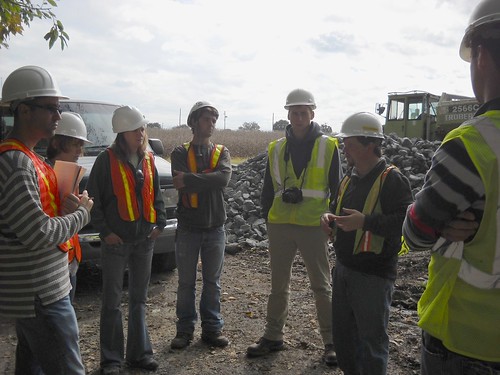
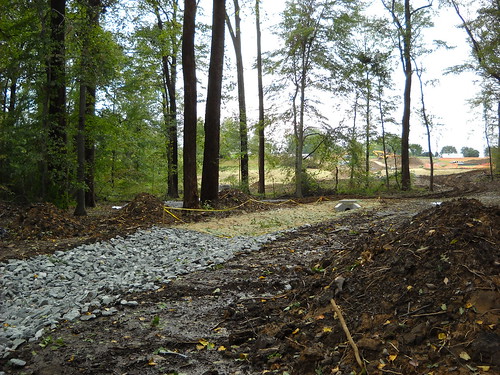
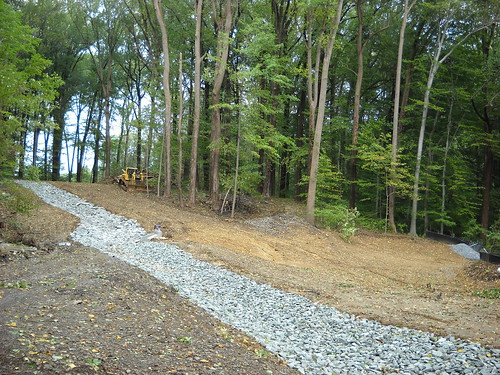

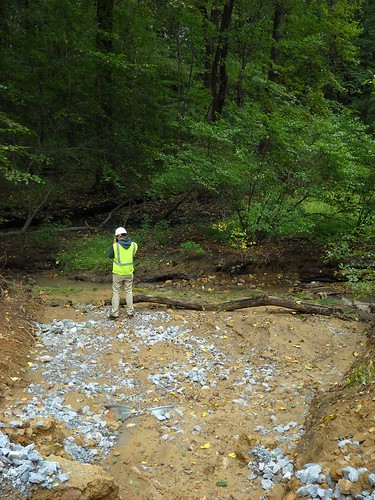
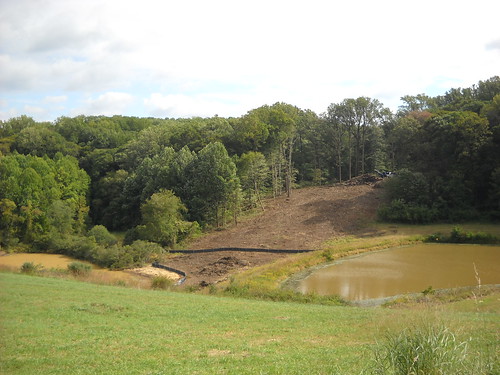




No comments:
Post a Comment